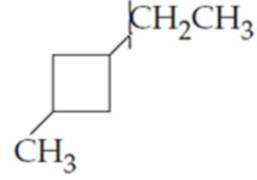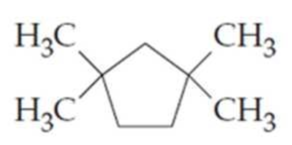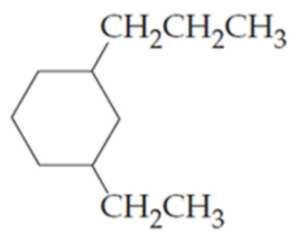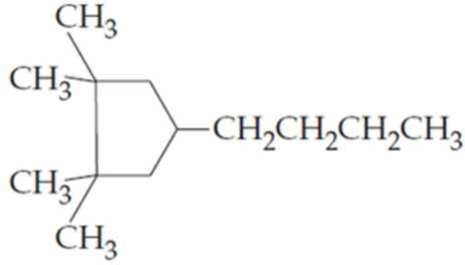
EP FUND.OF GENERAL,ORG...-MOD.MASTERING
8th Edition
ISBN: 9780134326061
Author: McMurry
Publisher: PEARSON CO
expand_more
expand_more
format_list_bulleted
Concept explainers
Textbook Question
Chapter 12, Problem 12.54AP
Name the following cycloalkanes:




Expert Solution & Answer
Want to see the full answer?
Check out a sample textbook solution
Students have asked these similar questions
Please give an intuitive explanation of the blood-brain barrier. Specifically, what is it, what is its structure and function, what types of cells compose it, etc.,..?
Obtain the sequence for the 5-HT receptor HTR1A and generate a hydropathy plot usingthe ExPASY tool ProtScale, the appropriate window, and the Kyte-Doolittle weightingalgorithm. How many transmembrane domains are present in this receptor?
From the reaction data below, determine whether the reaction is first order or second order and calculate the rate constant.
Time (s)
0
Reactant (mM)
5.4
1
4.6
2
3.9
3
3.2
4
2.7
5
2.3
Only a plot of In[reactant] versus t gives a straight line, so the reaction is
first order
. The negative of the slope, k, is
0.171
Chapter 12 Solutions
EP FUND.OF GENERAL,ORG...-MOD.MASTERING
Ch. 12.2 - Locate and identify the functional groups in (a)...Ch. 12.2 - Draw structures for molecules that fit the...Ch. 12.3 - Prob. 12.3PCh. 12.3 - There are two branched-chain isomers with the...Ch. 12.4 - Draw the following three isomers of C5H12 as...Ch. 12.4 - Prob. 12.6PCh. 12.4 - Prob. 12.7PCh. 12.4 - Draw both condensed and line structures for the...Ch. 12.5 - Which of the following structures represent the...Ch. 12.5 - Are the pairs of compounds shown below the same...
Ch. 12.6 - Identify each carbon in the molecule shown in...Ch. 12.6 - Prob. 12.12PCh. 12.6 - Prob. 12.13PCh. 12.6 - Draw and name alkanes that meet the following...Ch. 12.6 - Prob. 12.15KCPCh. 12.6 - Prob. 12.1CIAPCh. 12.6 - Prob. 12.2CIAPCh. 12.6 - Prob. 12.3CIAPCh. 12.8 - Prob. 12.1MRPCh. 12.8 - Prob. 12.2MRPCh. 12.8 - Prob. 12.16PCh. 12.8 - Write the structures of all singly chlorinated...Ch. 12.10 - Prob. 12.18PCh. 12.10 - Prob. 12.19PCh. 12.10 - What is wrong with the following names? It will be...Ch. 12.10 - Prob. 12.21KCPCh. 12.10 - Prob. 12.4CIAPCh. 12.10 - (a) What common produce items might you see...Ch. 12 - Convert the following models into line drawings...Ch. 12 - Prob. 12.23UKCCh. 12 - Prob. 12.24UKCCh. 12 - Give the IUPAC names for the following...Ch. 12 - Prob. 12.26UKCCh. 12 - What characteristics of carbon make possible the...Ch. 12 - Prob. 12.28APCh. 12 - Prob. 12.29APCh. 12 - Prob. 12.30APCh. 12 - For each of the following, give an example of a...Ch. 12 - Identify the highlighted functional groups in the...Ch. 12 - Identify the functional groups in the following...Ch. 12 - Propose structures for molecules that fit the...Ch. 12 - Prob. 12.35APCh. 12 - What requirement must be met for two compounds to...Ch. 12 - Prob. 12.37APCh. 12 - Prob. 12.38APCh. 12 - Prob. 12.39APCh. 12 - Prob. 12.40APCh. 12 - Give an example of a compound that meets the...Ch. 12 - (a)There are two isomers with the formula C4H10....Ch. 12 - Write condensed structures for the following...Ch. 12 - Prob. 12.44APCh. 12 - Prob. 12.45APCh. 12 - Which of the following pairs of structures are...Ch. 12 - Prob. 12.47APCh. 12 - Prob. 12.48APCh. 12 - Prob. 12.49APCh. 12 - What are the IUPAC names of the following alkanes?Ch. 12 - Prob. 12.51APCh. 12 - Write condensed structures for the following...Ch. 12 - Draw line structures for the following...Ch. 12 - Name the following cycloalkanes:Ch. 12 - Prob. 12.55APCh. 12 - Prob. 12.56APCh. 12 - Prob. 12.57APCh. 12 - Prob. 12.58APCh. 12 - Prob. 12.59APCh. 12 - Prob. 12.60APCh. 12 - Prob. 12.61APCh. 12 - Write the formulas of the four singly chlorinated...Ch. 12 - Write the formulas of the three doubly brominated...Ch. 12 - Identify the indicated functional groups in the...Ch. 12 - The line structure for pregabalin (Lyrica) is...Ch. 12 - Prob. 12.66CPCh. 12 - Prob. 12.67CPCh. 12 - Most lipsticks are about 70% castor oil and wax....Ch. 12 - Prob. 12.69CPCh. 12 - Prob. 12.70CPCh. 12 - Prob. 12.71CPCh. 12 - Which of the following structures represent the...
Knowledge Booster
Learn more about
Need a deep-dive on the concept behind this application? Look no further. Learn more about this topic, biochemistry and related others by exploring similar questions and additional content below.Similar questions
- Hair grows at a rate of about 20 cm/yr. All this growth is concentrated at the base of the hair fiber, where a-keratin filaments are synthesized inside living epidermal cells and assembled into ropelike structures. Two-chan 14 Protofilament 20-30 A Two-chain Intermediate flament -Protob Protofilament Cross section of a hair The fundamental structural element of a keratin is the a helix, which has 3.6 amino acid residues per turn and a rise of 5.4 A perlum. 54A (36) Amino terminus Carbon Hydrogen Oxygen Nitrogen group Carboxyl terminus Assuming that the biosynthesis of a helical keratin chains is the rate-limiting factor in the growth of hair, calculate the rate at which peptide bonds of a-keratin chains must be synthesized (peptide bonds per second) to account for the observed yearly growth of hair. 0422 rate of peptide bond formation: Income bonds/sarrow_forwardSpecific rotation is a measure of a solution's capacity to rotate circularly polarized light. The unfolding of the a helix of a polypeptide to a random conformation is accompanied by a large decrease in specific rotation. Polyglutamate, a polypeptide made up of only 1-Glu residues, has the a helix conformation at pH 3. When researchers raise the pH to 7, there is a large decrease in the specific rotation of the solution. Similarly, polylysine (1.-Lys residues) is an a helix at pH 10, but when researchers lower the pH to 7 the specific rotation also decreases, as shown in the graph. a Helix Specific rotation Poly(Glu) a Helix Random conformation Poly(Lys) Random conformation T + ° 2 4 6 В 10 12 14 PH Complete the statements about the molecular mechanism for these changes in specific rotation. Increasing the pH of a polyglutamate solution from 6 to 7 causes the carboxyl group of each glutamate residue Comed Artwer lose a proton. The negatively charged groups in each glutamate residue…arrow_forwardFrom the reaction data below, determine whether the reaction is first order or second order and calculate the rate constant. Time (s) 0 Reactant (mM) 6.2 1 3.1 2 2.1 3 1.6 4 1.3 5 1.1 Only a plot of 1/[reactant] versus t gives a straight line, so the reaction is 0.150 mM-1 s-1 . S second order . The slope, k, isarrow_forward
- From the reaction data below, determine whether the reaction is first order or second order and calculate the rate constant. Time (s) 0 Reactant (mM) 5.4 1 4.6 2 3.9 3 3.2 4 2.7 5 2.3 Only a plot of In[reactant] versus t gives a straight line, so the reaction is s-1. . The negative of the slope, k, isarrow_forwardA protein has a molecular mass of 400 kDa when measured by size-exclusion chromatography. When subjected to gel electrophoresis in the presence of sodium dodecyl sulfate (SDS), the protein gives three bands with molecular masses of 180, 160, and 60 kDa. When electrophoresis is carried out in the presence of SDS and dithiothreitol (DTT), three bands again form, this time with molecular masses of 160, 90, and 60 kDa. How many subunits does the protein have, and what is the molecular mass of each? four subunits: 180, 160, 90, and 60 kDa three subunits: 180, 160, and 60 kDa three subunits: 160, 90, and 60 kDa four subunits: 160, 90, 90, and 60 kDa Correct Answerarrow_forwardCalculate KM and Vmax from the following data: KM= i Vmax [S] (μM) vo (mM.s-¹) 0.1 0.34 0.2 0.53 0.4 0.74 0.8 0.91 1.6 1.04 μM mM s-1arrow_forward
- Propose a detailed chemical mechanism for the enzyme catalyzed reaction below and briefly note similarities, if any, to enzymes that we've studied. CO2 + CO2 2 CO2 HO CH3arrow_forwardState and describe the four stages of protein formation, please include the types of bonds at each stage.arrow_forwardPlease state and describe the four different types of non-covalent interactions.arrow_forward
- Pls help with these three questionsarrow_forward11. Which of the compounds below is the major product of the following reaction sequence? NOTE: PCC is pyridinium chlorochromate 1. BH 3 PCC 2. H2O2, NaOH NH HN ΗΝ, A B C CH3NH2, NaBH3CN D E NHarrow_forward10. Which of the compounds below is the major organic product obtained from the following reaction sequence? Ph Ph Ph A B OH 1. EtMgBr H2CrO4 Zn(Hg), aq. HCI PhCHO ? 2. H₂O, H+ Ph. C D Ph "ར HO OH Earrow_forward
arrow_back_ios
SEE MORE QUESTIONS
arrow_forward_ios
Recommended textbooks for you
- Essentials Health Info Management Principles/Prac...Health & NutritionISBN:9780357191651Author:BowiePublisher:Cengage
 Principles Of Radiographic Imaging: An Art And A ...Health & NutritionISBN:9781337711067Author:Richard R. Carlton, Arlene M. Adler, Vesna BalacPublisher:Cengage Learning
Principles Of Radiographic Imaging: An Art And A ...Health & NutritionISBN:9781337711067Author:Richard R. Carlton, Arlene M. Adler, Vesna BalacPublisher:Cengage Learning Biology (MindTap Course List)BiologyISBN:9781337392938Author:Eldra Solomon, Charles Martin, Diana W. Martin, Linda R. BergPublisher:Cengage Learning
Biology (MindTap Course List)BiologyISBN:9781337392938Author:Eldra Solomon, Charles Martin, Diana W. Martin, Linda R. BergPublisher:Cengage Learning



Essentials Health Info Management Principles/Prac...
Health & Nutrition
ISBN:9780357191651
Author:Bowie
Publisher:Cengage


Principles Of Radiographic Imaging: An Art And A ...
Health & Nutrition
ISBN:9781337711067
Author:Richard R. Carlton, Arlene M. Adler, Vesna Balac
Publisher:Cengage Learning

Biology (MindTap Course List)
Biology
ISBN:9781337392938
Author:Eldra Solomon, Charles Martin, Diana W. Martin, Linda R. Berg
Publisher:Cengage Learning
Biodiversity hotspots and functional diversity; Author: Stockholm Resilience Centre TV;https://www.youtube.com/watch?v=Gr_eIsFOKr4;License: Standard Youtube License